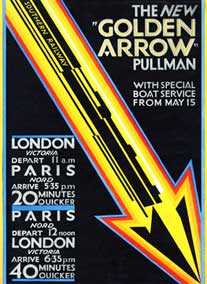Golden Arrow (train)

The Golden Arrow (French: Flèche d’Or) was a luxury boat train of the Southern Railway and later British Railways. It linked London with Dover, where passengers took the ferry to Calais to join the Flèche d’Or of the Chemin de Fer du Nord and later SNCF which took them on to Paris.
History


The Flèche d’Or was introduced in 1926 as an all-first-class Pullman service between Paris and Calais. On 15 May 1929, the Southern Railway introduced the equivalent between London and Dover. The train usually consisted of 10 British Pullman cars, hauled by one of the Southern Railway’s Lord Nelson class locomotives, and took 98 minutes to travel between London and Dover. Because of the impact of air travel and 'market forces' on the underlying economy, ordinary first- and third-class carriages were added in 1931. Similarly the first-class-only ferry, Canterbury, was modified to allow other classes of passenger.
.jpg)
The train service ceased at the outbreak of the Second World War in September 1939. It resumed after the war on 15 April 1946, initially running with the pre-war Pullmans and the Trianon Bar car, a converted twelve-wheeled Pullman.[1] As of 1949, the all-Pullman train was scheduled to depart from London (Victoria station) at 10:30, with the connecting train from Calais reaching Paris (Gare du Nord) at 17:30, and from Paris at 12:15, with the connecting train from Dover arriving in London at 19:30.[2] This worked out to a scheduled journey time of 6 hours eastbound and 6 hours, 15 minutes, westbound after accounting for the one-hour difference between Greenwich Mean Time and Central European Time.[2]
In 1951, a new set of Pullmans was built, as part of British Railways' celebration of the Festival of Britain.
In 1961, with the Kent Coast electrification scheme, the train became electric-hauled. This allowed an acceleration to 80 minutes for the down service and 82 minutes for the up service.[3] A decline in demand for rail travel between London and Paris saw the last Golden Arrow run on 30 September 1972, and in its later years only the first class section was advertised as a Pullman service.
Preservation
The preserved Bluebell Railway in Sussex runs a "Golden Arrow" train with Pullman cars "Car 64 (Christine)", "Fingall", "Car 76 (Lillian)", and an ex-LMS BGZ.
The main-line service was revived for a one-off event on 6 May 1994 when it formed part of the celebrations for the inauguration of the Channel Tunnel. It was hauled by the steam locomotive Britannia.
See also
- Night Ferry – sleeper train between London and Paris/Brussels (1936-1980)
- Eurostar – train service via the Channel Tunnel (since 1994)
References
Notes
- ↑ Kidner, R W (1958). The Southern Railway. South Godstone, Surrey: The Oakwood Press.
- ↑ 2.0 2.1 "Table 21: Golden Arrow (Flèche d'Or)". Cook's Continental Timetable (April 3–May 14, 1949 edition), p. 94. London: Thomas Cook Publishing.
- ↑ Southern Region Passenger timetable 5 May 1969 to 3 May 1970.
Bibliography
- Piggott, Reginald; Thompson, Matt (2012). Mile by Mile London to Paris: the entire railway journey by historic Golden Arrow and modern Eurostar mapped for the interested traveller. London: Aurum. ISBN 9781845137724.
External links
 Media related to The Golden Arrow at Wikimedia Commons
Media related to The Golden Arrow at Wikimedia Commons
- SEMG page - 2nd page
- http://www.dover-kent.co.uk/transport/golden_arrow.htm
- Bluebell Railway's Golden Arrow train.
- Winchester, Clarence, ed. (22 March 1935), "The Golden Arrow", Railway Wonders of the World, pp. 232–239, contemporary account of the train